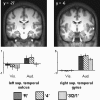Effects of modality on the neural correlates of encoding processes supporting recollection and familiarity
- PMID: 21852431
- PMCID: PMC3256569
- DOI: 10.1101/lm.2197211
Effects of modality on the neural correlates of encoding processes supporting recollection and familiarity
Abstract
Prior research has demonstrated that the neural correlates of successful encoding ("subsequent memory effects") partially overlap with neural regions selectively engaged by the on-line demands of the study task. The primary goal of the present experiment was to determine whether this overlap is associated solely with encoding processes supporting later recollection, or whether overlapping subsequent memory and study condition effects are also evident when later memory is familiarity-based. Subjects (N = 17) underwent fMRI scanning while studying a series of visually and auditorily presented words. Memory for the words was subsequently tested with a modified Remember/Know procedure. Auditorily selective subsequent familiarity effects were evident in bilateral temporal regions that also responded preferentially to auditory items. Although other interpretations are possible, these findings suggest that overlap between study condition-selective subsequent memory effects and regions selectively sensitive to study demands is not uniquely associated with later recollection. In addition, modality-independent subsequent memory effects were identified in several cortical regions. In every case, the effects were greatest for later recollected items, and smaller for items later recognized on the basis of familiarity. The implications of this quantitative dissociation for dual-process models of recognition memory are discussed.
Figures





References
-
- Ashburner J 2007. A fast diffeomorphic image registration algorithm. NeuroImage 38: 95–113 - PubMed
-
- Ashburner J, Friston KJ 2005. Unified segmentation. NeuroImage 26: 839–851 - PubMed
-
- Baker JT, Sanders AL, Maccotta L, Buckner RL 2001. Neural correlates of verbal memory encoding during semantic and structural processing tasks. Neuroreport 12: 1251–1256 - PubMed
-
- Craik F, Lockhart R 1972. Levels of processing: A framework for memory research. J Verb LearVerb Behav 11: 671–684
Publication types
MeSH terms
Substances
Grants and funding
LinkOut - more resources
Full Text Sources
